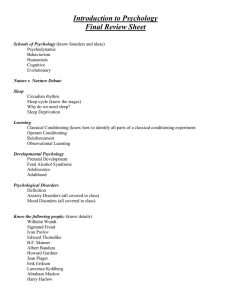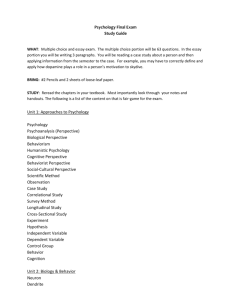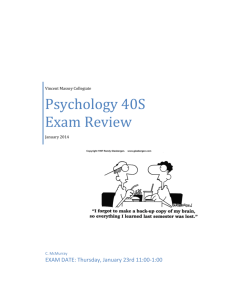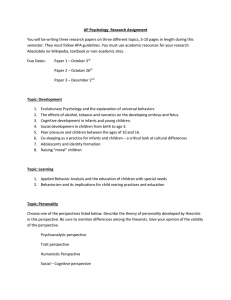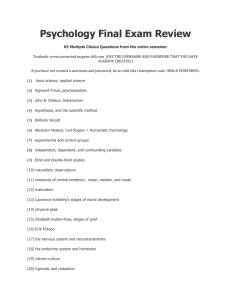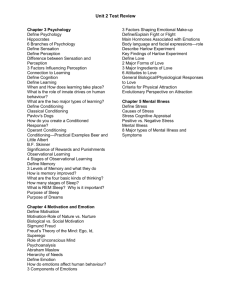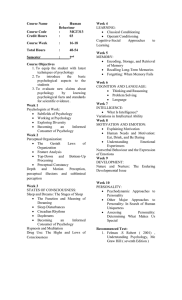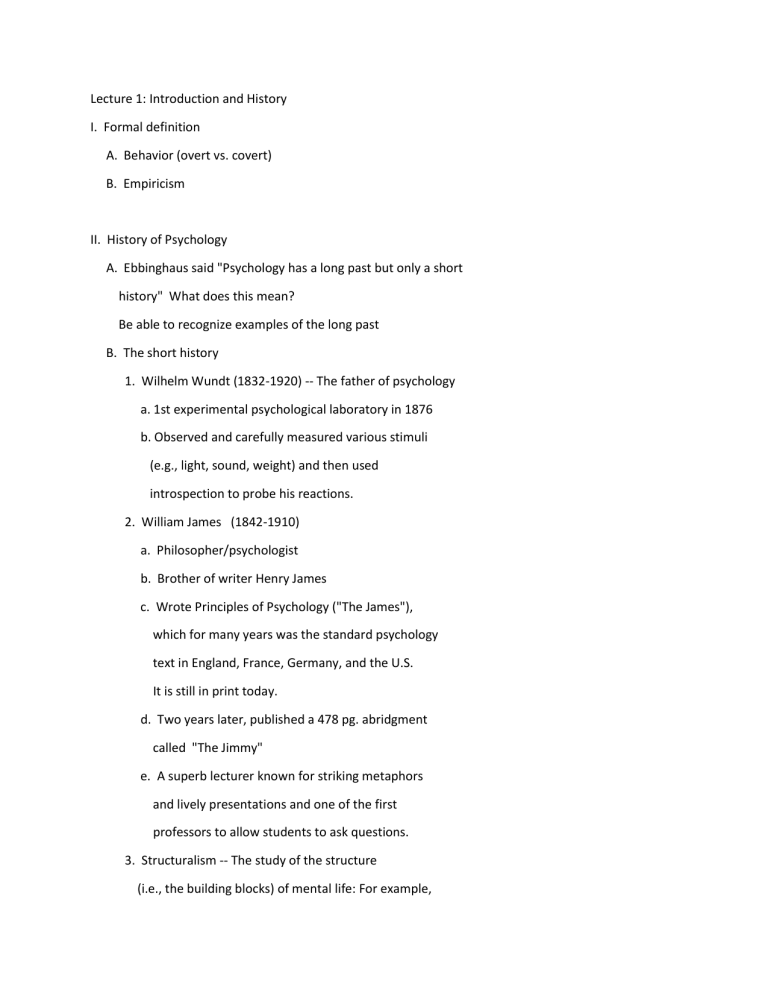
Lecture 1: Introduction and History I. Formal definition A. Behavior (overt vs. covert) B. Empiricism II. History of Psychology A. Ebbinghaus said "Psychology has a long past but only a short history" What does this mean? Be able to recognize examples of the long past B. The short history 1. Wilhelm Wundt (1832-1920) -- The father of psychology a. 1st experimental psychological laboratory in 1876 b. Observed and carefully measured various stimuli (e.g., light, sound, weight) and then used introspection to probe his reactions. 2. William James (1842-1910) a. Philosopher/psychologist b. Brother of writer Henry James c. Wrote Principles of Psychology ("The James"), which for many years was the standard psychology text in England, France, Germany, and the U.S. It is still in print today. d. Two years later, published a 478 pg. abridgment called "The Jimmy" e. A superb lecturer known for striking metaphors and lively presentations and one of the first professors to allow students to ask questions. 3. Structuralism -- The study of the structure (i.e., the building blocks) of mental life: For example, structuralists studied time perception by having subjects judge and estimate time intervals a. Wundt b. Edward Titchener -- Wundt's student, who came to the U.S. and set up a psychological laboratory at Cornell, which modeled Wundt's experimental method. c. Dominated American psychology for 2 decades, but there really are no structuralists today. 4. Functionalism -- The study of the functions of the mind and the adaptive value of consciousness a. William James b. G. Stanley Hall 1. Founded the American Psychological Association in 1892 2. One of the first developmental psychologists 3. Tried to establish the contents of children's minds 5. Psychodynamic Psychology -- Sigmund Freud a. Behavior is influenced by unconscious thoughts, impulses, and desires, which cannot be known directly. b. Interpreted dreams, which reflect unconscious desires c. Developed a theory of personality development, which includes the Oedipal Complex 6. Behaviorism -- The study of overt, observable behavior a. Ivan Pavlov -- Classical conditioning b. John Watson -- Instincts do not exist; habits are dominant c. B.F. Skinner -- Designed "Skinner Box" to study learning in animals 7. Gestault Psychology -- Study of thinking, learning, and perception, in whole units. German word Gestault means pattern or whole a. Max Wertheimer is one of its founders b. Whole is greater than sum of its parts (e.g., a musical melody) 8. Humanistic Psychology -- Study of human experience, problems, potentials, and ideals a. Carl Rogers -- unconditional positive regard b. Abraham Maslow: Self actualization (the process of developing one's full potential and becoming the best person one can be) 9. Neo-Freudianism -- The new psychodynamic theory developed by Freud's students and others a. Carl Jung -- collective unconscious b. Karen Horney -- focused on women; rejected Oedipal Complex c. Anna Freud & Melanie Klein -- Psychoanalysis with children C. Psychology Today 1. Eclectic -- drawing from many sources 2. The "Blind men and the elephant" fable 3. The biopsychosocial model 4. The different specializations (e.g., Industrial/Organizational Psych.) Lectures 2 and 3: Research Methods I. The Scientific Method A. The limits of intuition B. The Clever Hans story C. The essential components 1. Define a problem/question 2. Propose a hypothesis 3. Gather evidence / Test the hypothesis 4. Develop/Refine theory 5. Define follow-up problems and start all over II. Research Strategies A. Observation/Description 1. Case Study 2. Naturalistic Observation (observer effect) 3. Surveys (validity and reliability) B. Correlation 1. Positive 2. Negative 3. No correlation 4. Curvilinear relationship 5. Illusory correlation 6. Correlation does NOT imply causation C. Experimentation 1. Independent variable and dependent variable 2. Experimental group and control group 3. Random assignment 4. Significance 5. Placebo effect (single-blind and double-blind experiments) 6. Experimenter effect III. Research Ethics A. Informed consent vs. Deception B. Right to Privacy 1. Anonymity 2. Confidentiality C. Sensitivity to ethnic, racial, and religious minorities D. Debriefing Lecture 4: Child Development I. The Newborn: What can a neonate do? A. The senses B. Reflexes (grasping, rooting, sucking, and moro) C. Maturation (physical and emotional) D. Readiness II. Effects of Heredity and Environment on Development (Nature vs. Nurture) A. Heredity 1. chromosomes and DNA 2. genes (dominant and recessive) 3. temperament B. Environment 1. prenatal influences 2. maternal and paternal influences III. Development A. Social development 1. Imprinting: Conrad Lorenz 2. Attachment: Ainsworth's 3 types of attachment styles a. securely attached b. insecure-avoidant c. insecure-ambivalent B. Psychosexual Development 1. Freud's stages a. Oral Stage b. Anal Stage c. Phallic Stage (Oedipus and Electra Conflicts) d. Latency e. Genital Stage 2. Freud's Legacy: a. development occurs in stages b. children are sexual c. adolescence is a difficult period C. Language Development 1. Roots of language: innate vs. learned 2. Critical Period 3. Parantese D. Cognitive Development 1. Piaget a. assimilation and accomodation b. stages of development 1. sensorimotor 2. preoperational 3. concrete operational 4. formal operations 2. Post-Piaget highlights E. Deprivation and Enrichment 1. extreme deprivation 2. poverty 3. early stimulation: Harry Harlow's experiments with monkeys 4. enriched environments Lecture 5: Adolescence, Adulthood, and Old Age I. The stages of life: Erik Erikson A. birth - 1 : Trust vs. Mistrust B. age 1 - 3 : Autonomy vs. Shame and Doubt C. age 3 - 5 : Initiative vs. Guilt D. age 6 - 12 : Industry vs. Inferiority E. adolescence : Identity vs. Role confusion F. Young Adult : Intimacy vs. Isolation G. Middle Adult: Generativity vs. Stagnation II. Adolescence -- The Best of Times, the Worst of Times A. Puberty and maturation B. Search for identity: peer groups C. Moral Development 1. Kohlberg's stages (sample dilemma: the husband and the druggist) a. Preconventional b. Conventional c. Postconventional 2. Carol Gilligan's response a. Caring and responsibility b. "The porcupine and the mole" story III. Childhood problems A. Normal childhood problems B. Serious childhood problems 1. toilet training problems 2. feeding problems 3. learning disorders 4. behavior problems a. Attention Deficit Hyperactivity Disorder (ADHD) b. Oppositional Defiant Disorder (ODD) c. Conduct Disorder (CD) IV. Adulthood A. Marriage B. Family and parenting (Parenting styles: Diana Baumrind) 1. Authoritarian 2. Permissive 3. Authoritative C. Work D. The "mid-life crisis" myth V. Old Age A. Physical changes B. Cognitive changes 1. Intelligence 2. Memory C. Death and dying: Kubler-Ross's 5 stages Lecture 6: Biological Bases of Behavior I. The Neuron A. Parts of a Neuron 1. Dendrites 2. Cell Body or Soma 3. Axon 4. Myelin Sheath B. How Neurons Communicate 1. Synapse 2. Neurotransmitter 3. Threshold 4. Action Potential II. The Nervous System A. Peripheral 1. Somatic or Skeletal system 2. Autonomic a. Sympathetic (arousing) b. Parasympathetic (calming) B. Central (Brain and Spinal Cord) 1. Spinal Cord 2. Cerebral Cortex a. Occipital Lobe b. Parietal Lobe c. Temporal Lobe d. Frontal Lobe 3. Hemispheric Specialization; Split Brains 4. Brain Injuries (Broca's area & Wernicke's area) a. Aphasia b. Agnosia Lecture 7: Sensation I. Introduction to Psychophysics A. Definition and Examples B. Absolute Thresholds (the stimuli detected 50% of the time) II. Subliminal Stimulation A. Definitions 1. Limen -- the threshold or limit for awareness 2. Subliminal -- Any information below the normal limen B. Subliminal advertising C. Backward music lyrics III. Difference Thresholds A. Weber's Law: Just Noticeable Differences (JND) are a constant proportion of the original stimulus intensity B. Book example: Would you want your money back if you were overcharged $10 on the purchase of a shirt? What about a car? IV. Sensory Adaptation A. Examples 1. Going into a "cold" swimming pool that seems to warm up 2. Walking into a smelly room, holding your nose, and then forgetting B. Sensory Receptors respond best to changes in stimulation. Hubel: "We need above all to know about changes; no one wants or needs to be reminded 16 hours a day that his shoes are on." C. If change is necessary to prevent sensory adaptation, why doesn't vision adapt the way the other senses do? 1. The eye normally makes thousands of tiny movements every minute 2. These are caused by tremors in the eye muscles called physiological nystagmus. 3. This constant shifting of the eyes ensures that images always fall on fresh receptors V. Selective Attention A. The "seat of your pants phenomenon" B. The "cocktail party effect" VI. Vision -- the visible spectrum (wavelength of 400-700 nanometers) A. Structure of the eye(somewhat like a camera) 1. light enters through pupil (iris controls the pupil's size) 2. lens focuses image on a light-sensitive layer. 3. In the camera, this layer is the film; in the eye, it's the retina 4. The cornea, a clear covering at the front of the eye, as well as the lens are responsible for focusing. In cameras focusing is done by changing the distance between the lens and the film. B. Color Vision: The eye has two types of film 1. Rods (receptor cells) a. 100 million in each eye b. unable to detect color c. very sensitive to light, allowing us to see with very little light. 2. Cones (receptor cells) a. 6.5 million receptor cells in each eye b. work best in bright light c. pick up color and fine detail ("C" is for color) 3. Color Theories a. Trichromatic theory: three types of cones, each sensitive to one color (Red, Green, and Blue) Black and White come from Rods b. Opponent Process Theory: Visual system analyzes color into "either-or" messages; coding Red, blocks Green; Coding Blue, blocks Yellow. Thus Redish Green is impossible, but Yellowish Red (Orange) can occur c. Which theory is correct??? Both are. Researchers confirmed that (a) happens in the eye itself and (b) is how visual information is organized on its way to the brain. 4. Color Blindness (see the Ishihara test on page 103) a. Total color blindness is very rare. b. Color Weakness is more common (8% of men; <1% of women) c. Most color weakness is Red-Green; Yellow-Blue is rare d. Caused by changes in the genes that control the cones e. Recessive sex-linked trait (carried on the X chromosome) f. Since women have 2 X-chromosomes and the trait is recessive, if they receive one defective color gene, they will still have normal vision g. Carrots (vitamin A) help improve night blindness only if there's a deficiency, otherwise they won't help. VII. Sensation of pain A. Sensory Gating 1. Pain messages from different nerves, pass through the same neural gate 2. If the gate is closed by one pain message, other pain messages may not be able to pass through B. Methods of controlling pain 1. Lower anxiety 2. Raise control 3. Attention 4. Interpretation 5. Counterirritation -- Mildly painful stimulation relieve more severe pain by causing the body to release more endorphins. VIII. Hearing A. Audible range B. Hearing problems C. What happens when we age? IX. Taste -- where the different taste buds are located Lecture 8: Perception I. Perceptual constancies (e.g. shape; brightness) II. Perceptual groupings A. Figure and ground B. Gestault principles 1. nearness 2. similarity 3. continuity 4. closure 5. contiguity 6. common region C. Ambiguous stimuli and impossible figures III. Depth perception A. Monocular cues (accommodation) B. Binocular cues (convergence) C. Pictorial cues 1. linear perspective 2. relative size 3. light and shadow 4. overlap 5. texture gradient 6. relative motion D. The Moon Illusion IV. Perceptual Illusions (e.g., Muller-Lyer illusion) V. Perceptual Expectations (context matters) VI. Accuracy of eyewitness testimony (pg. 146-147) VII. Extrasensory Perception (ESP) (Parapsychology) A. Clairvoyance B. Telepathy C. Precognition D. Psychokinesis (not a perception, but also studied by parapsychologists Lecture 9: States of Consciousness I. Sleep and Dreams A. Circadian rhythm: the biological clock 1. from the Latin: circa-about; dies-day) 2. synchronized with the 24-hour day 3. jet lag; Staying up late on weekends a. Sunday night insomnia b. Monday morning Blues 4. Young adults isolated from clocks or daylight, typically adopt a 25 hour day 5. When in a time-free environment, most animals also exceed a 24-hour day a. explains why people have an easier time traveling West than East b. explains why workers adapt better to progressively later shifts c. explains why until our later years, we must discipline ourselves to go to bed on time and force ourselves to get up B. Biological rhythm: The five stages of sleep 1. occur every 90-100 minutes 2. uncovered in 1952 by a Univ. of Chicago grad. student 3. The five stages: a. Stage 1 (light sleep; just a few minutes long) b. Stage 2 (sleep spindles) c. Stage 3 (brief transition stage; delta waves) d. Stage 4 (deep sleep) e. REM (Rapid Eye Movement; paradoxical sleep; dreams) C. Why do we sleep? 1. Because we feel terrible when we are deprived a. major effect is sleepiness and general feeling of not being at one's best b. impaired creativity and concentration c. diminished immunity to disease d. irritability e. slowed performance f. occasional misperceptions on monotonous tasks (e.g., driving accidents) 2. Evolutionary adaptive because it hid us out of harm's way at night a. animals with least reason to fear predators and most need to graze, sleep less b. elephants and horses sleep 3 to 4 hours a day 3. Sleep helps us recuperate a. Our brain is actively repairing and reorganizing itself and consolidates memory b. Our lowered body temperature during sleep conserves energy for the day-time 4. Sleep may also play a role in the growth process. This may be one of the reasons we need less sleep as we get older. D. Sleep disorders 1. Insomnia (persistent problems of falling asleep or staying asleep) 2. Narcolepsy (periodic overwhelming sleepiness, causing one to collapse into brief periods of REM sleep) 3. Sleep Apnea (intermittent respiration stoppage during sleep) 4. Night Terrors (nonharmful terrors that occur during stage 4 sleep. Not nightmares) E. Dreams 1. What do we dream? 2. Why do we dream? a. Freud's theory of wish fulfillment (often very sexual) Example: A dream where you are being chased by a person with a gun is really...a dream about wanting a penis (women) or wanting a bigger penis (men) b. Other symbolic theories (usually not as sexual) Example: A dream where you are being chased by a person with a gun is really...symbolic of feeling overwhelmed by responsibilities c. Non-symbolic stories (even Freud, who loved to smoke cigars, acknowledged that "sometimes a cigar is just a cigar.") Example: A dream about a gun is really...a dream about a gun d. Modern theory: Random excitation of visual cortical neurons during brain activity in REM sleep Example: A dream about a gun is really...an innocent and non-meaningful firing of cortical neurons which our brain puts together into a story using stored memories. II. Drug-Altered Consciousness A. Three categories of psychoactive drugs 1. stimulants (substance that stimulate the nervous system) 2. depressants (substance that depresses the nervous system) 3. hallucinogens (substance that alters sensory impressions) B. Drug dependence 1. physical dependence (addiction) 2. psychological dependence 3. withdrawal symptoms 4. drug tolerance C. Patterns of abuse 1. experimental 2. social-recreational 3. situational 4. intensive 5. compulsive D. Potential factors leading to drug abuse E. Potential protective factors from drug abuse Lectures 10 and 11: Learning -- Conditioning and Beyond... I. What is learning? A. Definition B. The A-B-C's of learning 1. Antecedents 2. Behavior (overt or covert) 3. Consequences II. Classical Conditioning (or Pavlovian Conditioning) A. Emphasis on antecedents B. Discovered by Ivan Pavlov, while he was studying digestion in dogs C. Neutral stimulus (NS) is associated with the unconditioned stimulus (US), which reflexively produces the unconditioned response (UR). After several associated trials, the NS begins to produce the UR, even when the US is not present. At this point the NS has now become the conditioned stimulus (CS). D. Higher-order conditioning E. Extinction and spontaneous recovery F. Stimulus generalization and discrimination G. Classical Conditioning in humans 1. phobias (the story of Watson and "little Albert" 2. food aversions 3. vicarious conditioning II. Operant Conditioning (or instrumental conditioning) A. Emphasis is on consequences B. Method of study: The Skinner Box C. Types of consequences 1. positive reinforcement (primary vs. secondary) 2. negative reinforcement 3. punishment a. variables that affect punishment b. side-effects of punishment c. how to punish effectively D. Schedules of reinforcement 1. fixed ratio 2. variable ratio 3. fixed interval 4. variable interval E. Shaping F. Latent learning III. Beyond Conditioning A. Cognitive Learning 1. cognitive maps 2. discovery learning (insight learning) B. Modeling 1. observational learning 2. Bandura's "Bo-Bo doll" study Lecture 12: Memory I. The memory system A. encoding, storing, and retrieving B. Three stages of memory 1. sensory memory a. icons and echos b. very brief (few seconds or less) c. selective attention determines whether information goes into short-term memory 2. short-term memory (STM) a. temporary storehouse for small amounts of information b. often stored by sound c. very sensitive to interruption d. the magic number is seven (plus or minus two) 1. chunking 2. rehearsal 3. long-term memory (LTM) a. storehouse for important or meaningful information b. nearly limitless storage capacity c. stored on the basis of meaning and importance (i.e., file cabinet) d. constructive processing and pseudo-memories e. types of long-term memory 1. procedural memory 2. declarative memory a. semantic memory b. episodic memory II. Measuring memory A. recall vs. recognition B. relearning C. implicit memory D. exceptional memory (e.g., eidetic memory or photographic memory) IV. Forgetting A. Herman Ebbinghaus's forgetting curve B. Why do we forget? 1. encoding failure 2. retrieval failure (e.g., the tip-of-the-tongue phenomenon) 3. state-dependent learning 4. proactive and retroactive interference 5. repression V. Improving Memory A. rehearse, rehearse, and rehearse some more B. use effective organization (e.g., chunking) C. know about the serial position effect D. use cues E. overlearn F. have spaced practice to improve attention and minimize effects of interference G. sleep H. use mnemonic aids Example: Do you remember the Spanish word for "bird?" VI. Recovered Memory/False Memory Debate (read pgs. 261-263) Lecture 13: Cognition and Creativity I. Problem Solving A. Well-structured problems 1. algorithms 2. heuristics 3. analysis and synthesis B. Ill-stuctured problems 1. insight a. selective encoding b. selective combination c. selective comparison 2. Wolfgang Kohler (insight in apes) C. Hindrances to problem-solving 1. emotional barriers 2. cultural barriers 3. learned barriers a. functional fixedness b. prople bring old mental sets to new problems c. negative transfer: carryover of information that makes problem-solving more difficult. 4. perceptual barriers D. Aids to problem-solving 1. positive transfer example: people exposed to the "military problem" in which they had to capture a fortress, were more likely to solve the x-ray/tumor problem. 2. incubation: period of rest II. Judgment and Decision Making A. Common problems 1. bounded rationality (e.g., frequent use of intuition) 2. satisficing: choosing the 1st acceptable alternative 3. elimination by aspects: over-reliance on one attribute 4. ignoring the underlying probability of the event 5. all-or-nothing thinking 6. stereotypes B. Heuristics and bias 1. availability heuristic 2. representativeness heuristic 3. risk-averse bias III. Creativity A. Styles of thought 1. inductive vs. deductive thinking 2. logical vs. illogical thinking 3. fluency, flexibility, and originality 4. divergent and convergent thinking B. Tests of creativity 1. consequences test 2. anagrams test C. Stages of creative thought 1. orientation 2. preparation 3. incubation 4. illumination 5. verification D. The creative personality 1. normal or above normal intelligence 2. greater than average amount of knowledge and interests 3. open to new experiences 4. uninhibited about feelings and fantasies 5. enjoy symbolic thought, ideas, and concepts 6. value independence and prefer complexity 7. unconventional and unconforming in work, but otherwise they do not have particularly unusual or bizarre personalities E. Enhancing creativity (see pages 290-292) IV. Other important ideas A. Mental imagery (pages 267-270) B. Concepts (pages 270-272) C. Language (pages 273-276) D. Differences between experts and novices (page 281) Lecture 14: Motivation I. Model of motivation (Need --> Drive --> Response) A. Primary motives 1. based on biological need 2. homeostasis B. Stimulus motives C. Secondary motives D. Extrinsic vs. intrinsic motivation II. Hierarchy of Motives (Abraham Maslow's pyramid) A. Basic needs (from lower to higher) 1. physiological needs 2. safety and security 3. love and belonging 4. esteem and self-esteem B. Growth needs (meta needs) self-actualization: "Be all that you can be" C. Evaluation of Maslow's theory 1. fails to explain a martyr's behavior 2. not well documented by research 3. despite above short-cmings, Maslow has been very influential in the "understanding and appreciating of the rich interplay of human motives." III. Hunger: An important physiological need A. The hypothalamus B. Set point for proportion of body fat C. Obesity 1. external eating cues 2. dieting D. Eating disorders 1. Anorexia nervosa a. presenting symptoms (described in book) b. causes 1. family background 2. unrealistic body image 3. attempt at gaining control 4. presence of mood disorders c. treatment and prognosis 1. controlled medical diet 2. family therapy (e.g., Minuchin) 3. prognosis relatively poor (10% fatal) 2. Bulimia nervosa a. presenting symptoms (described in book) b. causes 1. unrealistic body image 2. sometimes concerned with control 3. guilt, shame, and anxiety c. treatment and prognosis 1. controlled medical diet 2. behavioral therapy 3. prognosis good if person seeks treatment IV. Theories of motivation A. Arousal Theory 1. sensation seeking 2. effects of level of arousal on performance 3. circadian rhythms B. Opponent-Process Theory 1. primary emotion followed by opposite emotion 2. over time, primary effect gets weaker, secondary effect gets stronger 2. skydiving example C. Social Motives D. Need for Achievement Lecture 15: Emotion I. General information A. The role of the autonomic nervous system 1. sympathetic (fight or flight) 2. parasympathetic (sudden death) B. Primary emotions II. Expressing and recognizing emotions A. Facial cues 1. similar across cultures (Ekman) 2. a smile is the most universal and easily recognized emotion 3. what do dilated eyes reveal? B. Body language 1. important cultural differences example: the gesture of forming a circle by bringing the thumb and first finger together. 1. relaxation or tension 2. liking or disliking C. Lie detecting 1. the polygraph machine 2. behavioral cues a. illustrators b. emblems III. Theories of emotion A. James-Lange Theory B. Cannon-Bard Theory C. Schachter's Cognitive Theory D. Contemporary Theory 1. attribution 2. facial feedback hypothesis Lecture 16: Health, Stress, and Coping I. Health Psychology A. Definition B. Behavioral risk factors 1. 45% of all deaths can be traced to unhealthy behavior 2. hard to stop unhealthy behavior (e.g., 1 in 10 smokers has long-term success) 3. prevention works better a. refusal skills training b. positive role models C. Health-promoting behaviors (the most important 5) 1. 7-8 hours of sleep per night 2. at or near the ideal weight for the height 3. never smoking cigarettes 4. rare (or moderate) use of alcohol 5. regular physical exercise II. Stress A. When is stress a problem? 1. when it is undpredictable (e.g., rat study) 2. when there is a lot of pressure (e.g., deadlines) 3. when the person has no control over the stress (e.g., unpleasant shock-avoidance task) 4. when it is intense or repeated (e.g., burnout) B. Acculturation: The stress of adjusting to a new culture 1. Many cultural stressors (e.g., poor language skills) 2. Four different styles of acculturation a. assimilation b. integration (or biculturalism) c. separation d. marginalization C. Managing stress 1. appraisal a. primary: "Am I in trouble?" b. secondary "What can I do about it?" (see Learned Helplessness section) 2. coping a. problem-focused b. emotion-focused 3. reducing a. defense mechanisms (e.g., repression) b. other personality traits (e.g., Type B) c. personal habits d. social support III. Learned Helplessness A. Definition: Perceived lack of control over the environment. B. Seligman's original studies of learned helplessness is dogs C. Learned helplessness in people 1. explanatory style (attribution) is the key a. temporary vs. permanent b. specific vs. universal c. internal vs. external 2. poor attributions lead to learned helpless and depression D. Unlearned Helplessness ("Learned Optimism") 1. mastery training 2. "forced" control 3. cognitive therapy (people only) IV. Frustration and Conflict A. Different ways of dealing with frustration 1. direct aggression 2. displaced aggression 3. persistence 4. circumvention 5. withdrawal/escape B. Three main types of conflicts 1. approach-approach 2. avoid-avoid 3. approach-avoid Intelligence I. Defining intelligence A. Important elements of intelligence 1. Abstract thinking or reasoning 2. Problem-solving ability 3. Capacity to acquire knowledge 4. Ability to adapt to one's environment 5. Memory (some disagreement on this one) B. Operational definition C. Different from aptitude and achievement II. Testing Intelligence A. Properties of a good test (psychometrics) 1. Validity 2. Reliability 3. Objectivity 4. Standardization and norms B. Chronoligical age vs. mental age C. History of intelligence testing 1. Alfred Binet (asked to distinguish between children who could not learn from those that just did not want to do so. 2. Army Alpha and Army Beta (Yerkes) a. validity and reliability (in WWI and today) b. historical significance c. culturally and racially biased 3. Modern tests of intelligence a. Wechsler Adult Intelligence Scale (WAIS) b. performance and verbal tests c. less culturally and racially biased D. Variations in intelligence 1. The normal curve (mean=100; SD=15) 2. Terman's "Termites" and misconceptions about gifted children (IQ > 130) 3. Mental retardation (IQ < 70) 4. The influences of heredity and environment Lecture 18: Personality I. Personality Theories A. Trait theories 1. Traits vs. states 2. Hans Eysenck's two main dimensions a. introvert vs. extrovert b. emotionally stable vs. emotionally unstable 3. Gordon Allport (1961) a. common traits vs. individual traits b. cardinal, central, and secondary traits 4. Raymond Cattell (1965) a. used factor analysis b. surface traits and source traits c. Cattell's 16 PF 5. The "Big Five" (Go Penn!!) a. extroversion b. agreeableness c. conscientiousness d. neuroticism e. openness to experience 6. Trait-situation interactions B. Psychoanalytic Theory 1. Structure of the personality a. The id 1. operates on the pleasure principle 2. life instinct (Eros) 3. death instinct (Thenatos) b. The ego -- the reality principle c. The superego 1. conscience 2. ego ideal 2. Levels of awareness a. conscious b. preconscious c. unconscious 3. Personality development -- review the psychosexual stages in lecture 4. 4. neo-Freudians a. Karen Horney (3 modes of interacting) b. Carl Jung 1. personal vs. collective unconscious 2. archetypes (e.g., anima and animus) C. Learning Theory (behaviorist) 1. interested in external causes of actions 2. Personality = Behavior a. habits make up personality b. four elements of learning 1. drive 2. cue 3. reward 4. response 3. Social-learning theory a. stress is on social relationships b. psychological situation c. expectancy d. reinforcement value 4. Critical situations in development a. feeding b. toilet training or cleanliness training c. sex training (learning sex-appropriate behavior) d. learning to express anger and aggression D. Humanistic Theory 1. Maslow and self actualization 2. Carl Rogers' self theory a. self image b. true self c. ideal self II. Personality Testing (consider strengths and limitations of each method) A. Direct observations and rating scales B. Personality questionnaires 1. Kiersey; MBTI 2. MMPI C. Projective tests 1. Rorschach Inkblot Test 2. Thematic Apperception Test (TAT) Lectures 19 and 20: Psychopathology I. Defining abnormality A. Several different methods 1. Statistical definitions 2. Subjective discomfort 3. Social non-conformity B. Other considerations 1. cultural relativity a. emic vs etic perspectives b. example: Jamaica vs. U.S. children 2. situational context II. Classifying mental disorders A. Continuous vs categorical classifications B. The DSM-IV 1. mostly categorical 2. multiaxial a. Axis I: clinical disorders b. Axis II: personality disorders and mental retardation c. Axis III: physical problems d. Axis IV: enviornmental risk factors e. Axis V: Assessment of functioning III. Major mental disorders (know main characteristics of each) A. Mood disorders 1. Depression 2. Bipolar disorder (mania and depression) 3. Post-partum depression 4. Seasonal-Affective Disorder B. Anxiety Disorders 1. Phobias 2. General Anxiety Disorder 3. Obsessive-Compulsive Disorder a. obsession (thoughts) b. compulsions (behaviors) C. Somatoform of Psychosomatic disorders -- physical symptoms without any physical cause. D. Dissociative Disorders 1. Fugue state 2. Dissociative Identity Disorder (formerly Multiple Personality Disorder) E. Personality Disorders 1. Antisocial Personality Disorder 2. Borderline Personality Disorder F. Sexual Disorders 1. Paraphilias 2. Rape G. Thought Disorders (Schizophrenia) 1. presence of hallucinations and delusions 2. Several different subtypes a. Catatonic b. Disorganized c. Paranoid d. Undifferentiated e. Residual 3. Causes of schizophrenia a. heredity b. environment c. brain chemistry Lecture 21: Psychopathological Interventions I. Types of therapy A. Individual vs. Group vs. Family B. Global vs. Problem-focused II. Global Therapies A. Psychoanalytic (Sigmund Freud) 1. focus on unconscious and child experiences 2. techniques a. dream interpretation b. free association c. analysis of transference d. analysis of resistance B. Humanistic (Carl Rogers) 1. non-directive 2. focus on unconditional positive regard 3. techniques a. reflection b. acceptance c. empathy C. Gestalt (Fritz Perls) 1. more directive (sometimes confrontational) 1. focus on the here and now 2. aims to rebuild thinking and feelings III. Problem-focused A. Behavioral therapy 1. focus on external events 2. several types a. aversion therapy b. systematic desensitization c. behavior modification through the use of token economies B. Cognitive therapy 1. focus on changing inaccurate or irrational thinking 2. focus in on present 3. techniques a. challenging irrational thoughts b. very directive C. Biological therapy 1. Medication 2. ECT Lecture 22: Relationships and Sexuality I. The phases of a relationship A. Inclusion B. Response C. Affection D. Care E. Trust F. Playfulness G. Sexuality II. Differences between friendship and love A. sexual contact B. Rubin's love and liking scales 1. love scale assesses feelings of intimacy possessiveness, and preoccupation. 2. liking scale measures feelings of respect and perceived similarity 3. findings from a study of college students III. Theories of love A. Sternberg's model of love 1. three separate components a. passion b. intimacy c. commitment 2. consummate love (all 3 components) 3. romantic love (passion and intimacy) 4. companionate love (intimacy and commitment) 5. empty love (commitment alone) B. Hendrick and Hendrick's model 1. six different styles a. eros b. ludus c. storge d. pragma e. mania f. agape 2. men and women differ in their love styles 3. college couples tended to have "matching" styles 4. styles were related to relationship satisfaction IV. How do we know when we're in love (arousal theory) A. Rickety bridge study B. Attractive/Unattractive picture study V. Sexual behavior (not covered in lecture. Please read text.) A. Sux roles and socialization B. Sexual arousal C. Sexual orientation D. Human sexual response (male and female) E. Sexual attitudes and behavior 1. rape 2. risky behavior 3. AIDS Lecture 23: Social Roles and Social Influence I. Social Roles A. Types of roles 1. ascribed 2. achieved B. Role impact (Zimbardo's prison study) C. Role conflict II. Social Groups A. Structure and cohesion B. Status C. Norms (autokinetic effect) III. Social Perception A. Attribution theory 1. external vs. internal cause 2. consistency and distinctiveness 3. situational demands and discounting 4. consensus 5. self-handicapping 6. fundamental attribution error 7. the double-standard B. Social Comparison theory 1. group membership fills needs for social comparison 2. downward and upward comparisons IV. Social Influence A. Social Power 1. reward power 2. coercive power 3. referent power 4. expert power B. Conformity 1. Asch's conformity experiments 2. group factors in conformity a. groupthink b. group sanctions c. importance of group membership d. size of group e. unanimity C. Obedience (Milgram's obedience studies) D. Compliance 1. The Foot-in-the-Door Effect 2. The Door-in-the Face Effect 3. The Low-Ball Technique 4. Passive Compliance 5. Assertiveness Training V. Social Relationships (not in lecture; read pp. 640-645) A. Interpersonal attraction 1. physical proximity 2. physical attractiveness and the "halo effect" 3. competence (but not too much of it) 4. similarity 5. Self-disclosure and reciprocity 6. Social-Exchange theory B. Love and attachment 1. review love and sexuality in lecture 22. 2. influence of early attachment styles 3. evolution and mate selection Lecture 24: Attitudes and Prejudice I. Attitude Formation A. Direct contact B. Interactions with others C. Child rearing D. Group membership E. Chance conditioning II. Attitude Measurement A. Open-ended interviews B. Social distance scale C. Attitude scale III. Persuasion A. Characteristics of the messenger, the message, and the audience B. Role-playing C. Cognitive Dissonance theory D. Forced attitude change 1. Brainwashing a. unfreezing b. change c. refreezing 2. Cults a. recruitment b. conversion IV. Prejudice A. Institutionalized prejudice (e.g., racism, sexism, ageism) B. Becoming prejudiced 1. scapegoading 2. personal vs. group prejudice 3. intergroup conflict a. social stereotypes b. symbolic prejudice 4. brown/blue-eyed children study C. The prejudiced personality 1. authoritarian 2. ethnocentric 3. dogmatic D. Fighting prejudice 1. change in metaphor: "tossed salad" not "melting pot" However, there is still often a discrepancy between cognitions and emotions 2. equal-status contact 3. superordinate goals 4. "jigsaw" classrooms and mutual interdependence 5. a few other ideas a. beware of stereotypes b. seek individual information c. avoid "Just-World" beliefs d. be aware of self-fulfilling prophecies e. educate yourself about other cultures V. Aggression and Prosocial behavior A. Aggression 1. biological instincts 2. connected to frustration 3. social learning theory a. effects of television b. effects of pornography B. Prosocial Behavior (bystander intervention) 1. noticing 2. defining an emergency 3. taking responsibility (the bystander effect) 4. characteristics of the person needing help
